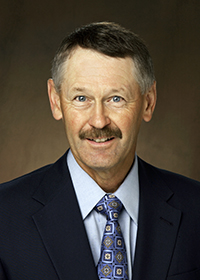Ask A Researcher
September 2014
Pull Factors Measure Retail Trade Performance

Randal Coon is a research specialist with NDSU's Department of Agribusiness and Applied Economics. He discusses an economic tool used to measure a community's retail trade performance.
Q: How do you define “pull factors”?
A: Generally, pull factors measure how effective a community's retail sector is attracting its potential consumer purchases. The tool compares the amount of a community's retail sales to the amount of spending capacity of its population. If a community's retail sales are equal to the spending capacity of its population, then the community's pull factor would be equal to one. A pull factor greater than 1.0 means that community is attracting a larger number of customers than would normally be drawn from the local population, while a pull factor less than 1.0 indicates that the community is losing retail purchases to other trade centers.
Q: How are pull factors calculated?
A: A pull factor for a community is calculated as the Trade Area Capture (i.e., a surrogate for the number of customers in that community), divided by the Trade Area Population (i.e., the number of people living in that community). To estimate Trade Area Captures, a survey of spending patterns of North Dakota residents was used. Secondary data sources provided the other required information, which included per capita income, personal income, population, and taxable sales and purchases. Data sources included the Bureau of Economic Analysis, The Census Bureau, and the North Dakota Tax Department. Populations required for the calculations were subdivided to the city, town, unincorporated, and township levels. All of the state's population was accounted for by place of residence.
Q: What are the pull factors for North Dakota cities telling us?
A: To calculate the pull factors, the cities/towns in North Dakota have been divided into six categories: wholesale - retail shopping centers; complete shopping centers; partial shopping centers; full convenience centers; minimum convenience centers; and hamlets (i.e., the smallest towns that we have in ND). Pull factors have been calculated for cities and towns in North Dakota for the 1980 to 2011 period. Generally, pull factors decline as the trade center classification goes from the wholesale-retail centers to hamlets. The cities/towns combined into the wholesale-retail centers have had pull factors near the 1.0 measure for the analysis period, followed by complete shopping centers (about 0.9), partial shopping centers (about 0.75), full convenience centers (about 0.68), minimum convenience centers (about 0.5), and hamlets (about 0.4). Pull factors vary from year to year for each community, but as the communities become smaller they offer less retail opportunities and have lower pull factors.
Q: What are the pull factors for some individual cities?
A: The wholesale-retail centers consist of Bismarck, Fargo, Grand Forks, and Minot. Bismarck, Grand Forks, and Fargo all had pull factors greater than 1.0 in 2009, but have declined to slightly less than that by 2011. Minot, which has been impacted by oil development in the Bakken Formation, has increased its pull factor from 0.94 in 2008 to 1.04 in 2011. Dickinson and Williston were the only two cities in the complete shopping group to have pull factor greater than 1.0 from 1980 to 2011. Most cities in the partial shopping category have experienced declining pull factors since 2000 with the exception of some located in the oil development area. A similar situation generally exists for the other classifications (i.e., full convenience, minimum convenience, and hamlets).
Q: How has oil development in North Dakota affected pull factors for cities/towns in those areas?
A: Oil development has had a significant impact on pull factors for cities in the oil producing counties. Data used to calculate pull factors has been changing with personal income, per capita income, population, and taxable sales and purchases, all increasing rapidly in recent years in the oil development area. Socio-economic growth in the oil development area has been well documented, but the entire state has benefited from the increase of business activity and population growth. Minot, a wholesale-retail center located on the eastern edge of oil development, has increased its pull factor to 1.04 by 2011. Tioga, a partial shopping center located in the oil development area, has increased its pull factor from 0.88 in 2000 to 4.01 in 2009 and 8.38 in 2011. The increased pull factor for Dickinson to 1.17 in 2011 has also been affected by energy development. Williston, a complete shopping center located at the epicenter of the oil development, had a pull factor of 3.27 in 2011, much higher than the 0.88 pull factor in 2000. Stanley had its pull factor increase from 0.74 in 2000 to 1.75 in 2011. Clearly, the expansion of the economy in the oil development area is having a significant effect on the retail sales in cities in northwestern North Dakota. The 2012 and 2013 pull factors have not been calculated yet, but will provide additional insight into the impact oil development has had on retail sales in North Dakota.
